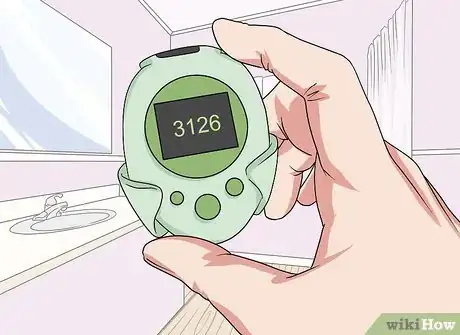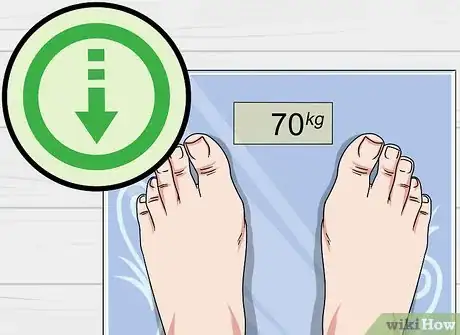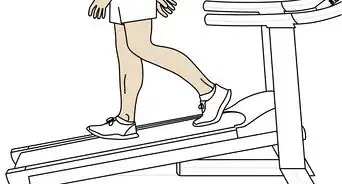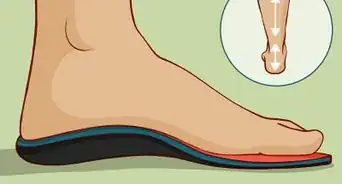wikiHow is a “wiki,” similar to Wikipedia, which means that many of our articles are co-written by multiple authors. To create this article, 25 people, some anonymous, worked to edit and improve it over time.
There are 10 references cited in this article, which can be found at the bottom of the page.
This article has been viewed 126,130 times.
Learn more...
In recent years, physical fitness has become a global health concern, so more people than ever are looking for ways to work exercise into their daily routines.[1] For many, pedometers offer a convenient way to track daily physical activity (usually in the form of the number of steps taken). These handy devices are smaller than a pager, affordable, widely-available, and easy to start using with just a few simple "steps!"
Steps
Recording Your Steps
-
1If necessary, set the length of your steps. Most kinds of pedometer will automatically be able to detect your steps without any input from you. However, to be able to calculate the total distance you've walked, some require you to set the average length of your stride. If you're unsure of whether your pedometer requires this information, consult its operating manual.
- To find your average step length, grab a tape measure, start walking in a straight line, stop suddenly at a random step (like, for instance, step number seven), and measure the distance between the heels of your feet.
- No two models of pedometers are exactly alike, so the way you input your average step length for one may not be the same as for others. Some common pedometers are set like this: Press the "Mode" button until you see a reading for your miles traveled. Press "Set." You will see a default step length setting — usually about 30 in (75 cm). Adjust your step length with the appropriate buttons on the pedometer.
-
2Fasten the pedometer on. Pedometers count your steps by recording the number of times they feel a "shake" or "bump" that occur throughout the day. Usually, these happen with each step you take, so the number you see on your pedometer is usually a good (sometimes even exact) measure of how many steps you've taken. Because pedometers work this way, for a pedometer to be able to count your steps, it has to be attached to your clothes or body.
- The most common types of pedometers are worn by clipping them to the edge of a pocket, the waistband of a pair of pants, or a belt so that they rest on the hips.[2] These usually work best if they're aligned with the center of the thigh. If your pedometer comes with a safety band, try fastening it to a belt loop to prevent the pedometer from falling off.
- Note that not all pedometers are worn at the waist. Some, for instance, are worn around the wrist.[3] In this case, the pedometer is usually secured exactly like a wristwatch. Some high-end devices called accelerometers that function similarly to pedometers are even worn on the foot or ankle.
Advertisement -
3Start moving! Once you've attached your pedometer securely and ensured that it's on, you can usually begin moving and it will count your steps automatically. Every time the pedometer shakes from the up-and-down motion of an average stride, it registers another step. No input is needed on your part — you can simply forget about your pedometer until the end of the day!
-
4Check the pedometer at the end of the day. When you're done walking for the day (for instance, right before you go to bed), remove your pedometer and check the number of steps you've made. If you're aiming to increase your fitness, record number and take pride in the day's accomplishment. Over time, you can increase your fitness by gradually raising the number of steps you take per day.
-
5Repeat every day. Over the next few days, get into the routine of putting your pedometer on once you start moving and taking it off before you get into bed. Record or make note of each day's results. These simple actions are all you need to do to start a record of your daily step counts! Once they become a habit, you should barely even notice your pedometer while you wear it.
Setting Step Goals
-
1Set regular goals. Many people start wearing pedometers as part of an effort to get in shape. In these cases, it's usually easiest to get motivated to take more steps by setting small, clearly-defined goals for yourself. These goals should provide some increasing level of challenge from week to week, but should be completely within your grasp.
- Many walking resources recommend that increasing your pace by about 500 steps per week is a reasonable fitness goal. In other words, you'd aim to walk about 3,500 steps per day during your first week, 4,000 during your second, and so on.
-
2Set ambitious long-term goals. It's not practical to simply increase your step count each week forever. At some point, most people want to find a sustainable level of activity that meets their fitness needs and can be easily balanced with their other work and life obligations. This should be your long-term goal. Give yourself plenty of time to achieve this by slowly ramping up your step counts from week to week until it's within your grasp. Don't aim for your final goal right off the bat — suddenly imposing major challenges on yourself is a great way to fail and discourage yourself.
- One long-term step goal that's widely advertised as being desirable for adults is 10,000 steps per day. For someone with an average-length stride, this is a little less than 5 mi (8 km). While 10,000 steps per day can be a great fitness goal, it's worth noting that the goal may be unsustainable for some groups of people (like the ill or elderly)[4] . In addition, this level of activity is probably too low for teens and children.[5]
-
3Keep a journal of your daily results. To track long-term progress, it's a wise idea to keep track of your daily pedometer counts in a step journal. Once you've accumulated a few months' worth of data, it's easy to see the changes you've made — you can even make a line graph to get a visual representation of your progress.
- Note that your journal doesn't have to be an actual, paper one. Digital journals work just as well. Spreadsheet programs like Microsoft Excel make it exceptionally easy to transfer your data into a graph.
-
4When in doubt, consult your doctor. If you're unsure of whether your short-term or long-term step goals are reasonable, talk to your doctor. Only a trained medical professional will be able to tell you exactly what sorts of exercise are right for you based on your unique medical history.
- If you have a medical condition that affects the level of exercise you can perform (like, for instance, heart disease), consult with your doctor before you start using a pedometer, not after. Though the dangers of walking are usually quite low, some medical problems can change this.
Boosting Your Fitness
-
1Walk at a brisk pace. In general, the quicker you move, the harder your body has to work, the more energy it uses, and the more calories you burn. For instance, a moderate-weight person can burn about 70 more calories per hour by increasing their walking speed from 3.5 to 4.5 mph (5.6 to 7.2 km/h).[6] Thus, if you're interested in either burning calories or boosting your athletic potential, you'll want to move faster, rather than slower.
- Most health resources define "brisk-paced" walking at about 3.0 mph (4.8 km/h) or greater — if you're unsure of where to start, this is a good benchmark pace.[7]
- Note that, in addition to providing better exercise, brisk-paced walking also decreases the amount of time you'll need to take to walk any given distance, freeing up more time for you to do other things with your day!
-
2Use movements besides walking. As noted above, pedometers don't just measure steps while walking. Since they record any sort of rhythmic, repetitive, up-and-down motion, they're also useful for recording your steps during any number of other exercise activities. Keep in mind, however, that because your average stride length may differ for these activities, the distance reading you get may not be accurate. Below are just a few other activities for which a pedometer can measure your "steps":
- Running
- Hiking
- Climbing stairs
- Jump roping
- Some pedometers even have options to measure your speed and distance on a bicycle.
-
3Use your pedometer to help you count calories. In general, people lose weight over time if they spend more calories per day than they take in from their food. If walking is your only form of daily exercise, you can use your pedometer to help you stay on track for your weight loss. Since your pedometer can tell you how far you've walked, you can use any online calorie calculator to find how many calories you've burnt based on the distance you walked. Add this to your basal metabolic rate (BMR), the number of calories you burn simply from living, and you'll know approximately how many calories you spent during the day.
- For instance, a 180 lb (81 kg) person who walks five miles over the course of three hours during the day burns about 720 calories.[8] If this person's BMR is about 1,800 calories (typical for a young 6-foot tall male)[9] they burnt about 2,520 calories during the day, so eating fewer calories than this would cause them to lose weight.
-
4Keep yourself motivated for the long haul. Keeping your daily activity at a reasonable level isn't like a New Year's resolution that can be abandoned a few weeks after it's made — it should be a lifelong commitment. People who make a habit of exercising (with or without a pedometer) experience demonstrably longer, healthier lives on average than people who don't.[10] However, these benefits are only the result of sustained, long-term fitness commitments, so try to stay motivated as you use your pedometer to make the task of consistently exercising much easier. Below are just a few ways to get "pumped up" for your fitness goals:
- Remind yourself of your goals when you don't feel like exercising.
- Reward yourself when you achieve minor goals.
- Get a healthy amount of rest every day.
- Listen to exciting, captivating music.
- Watch inspirational movies.
- Take occasional breaks from your fitness routine.
- Tell other people about your goals.
Community Q&A
-
QuestionHow many miles is 10,000 steps?
 Community AnswerAbout 5, roughly.
Community AnswerAbout 5, roughly. -
QuestionWill increasing my stride improve pedometer accuracy?
 Community AnswerIt does for me, and I think it's because I'm especially short, so if my strides aren't long, it won't pick up every step I take.
Community AnswerIt does for me, and I think it's because I'm especially short, so if my strides aren't long, it won't pick up every step I take. -
QuestionWhere can I buy a pedometer?
 Community AnswerAny department store that has a sports and fitness section, or they can easily be ordered online.
Community AnswerAny department store that has a sports and fitness section, or they can easily be ordered online.
Warnings
- If the pedometer falls, it will break or you will lose it. Make sure it's attached tightly to your waistband.⧼thumbs_response⧽
- Be careful of crafty people that will reset your pedometer when you're not looking.⧼thumbs_response⧽
References
- ↑ http://healthland.time.com/2012/07/18/lack-of-exercise-as-deadly-as-smoking-study-finds/
- ↑ http://www.campusrec.illinois.edu/wellnesscenter/iWalk/pedometer.html
- ↑ http://www.engadget.com/2013/11/06/fitbit-force-review/
- ↑ http://www.pedbikeinfo.org/data/faq_details.cfm?id=1217
- ↑ http://www.ncbi.nlm.nih.gov/pubmed/14715035
- ↑ http://www.health.harvard.edu/newsweek/Calories-burned-in-30-minutes-of-leisure-and-routine-activities.htm
- ↑ http://www.health.harvard.edu/press_releases/pedometers-motivate-people-to-exercise
- ↑ http://www.shapesense.com/fitness-exercise/calculators/walking-calorie-burn-calculator.aspx
- ↑ http://www.myfitnesspal.com/tools/bmr-calculator
About This Article
To use a pedometer, fasten it to the edge of your pocket, waistband, or belt so it’s near your hips and legs to more accurately count your steps. However, if you have a pedometer that’s meant to be worn around your wrist or on your shoe, make sure to attach it securely. Once your pedometer is set, start walking, running, or hiking to let it count your steps. At the end of the day, take your pedometer off to see how many steps you took. To learn how to set fitness goals with your pedometer, keep reading!







































































